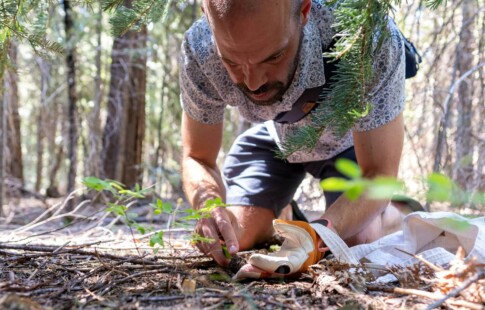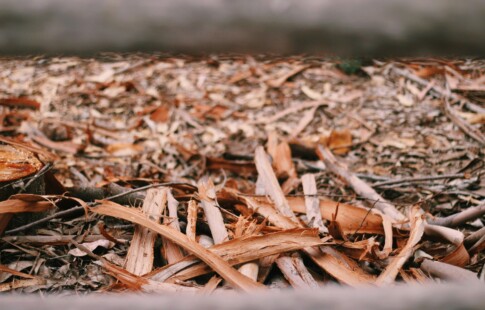
How to Find Clean Water in Nature: 9 Tips and Tricks
We are reader-supported. When you buy through links on our site, we may earn affiliate commission.
Human beings need water to survive. While you can live for several days without food, you’ll only last three days without the wet stuff — if other conditions don’t quickly dehydrate you. What can you do if you find yourself stranded in the wilderness with an empty canteen? First, try not to panic. Then, follow these nine tips and tricks to find clean water in nature.
1. Open Your Ears
Getting mindful for a moment by practicing the 5, 4, 3, 2, 1 technique to quell anxiety can help you fend off a panic attack. It might also tune you in to the sweet sound of your salvation.
Your best bet for clean water in nature is a running stream and they broadcast their presence with a melodic babble. Is that one of the three things you can hear? If not, how about insects humming and frogs chirping? Pond contents might not look too appealing, but you can purify them with the handy filtration straw you take on every hike (right?).
2. Seek Vegetation
Humans aren’t the only creatures that need water. Plants also require them to thrive, and they can’t pack up a back frame and hike to the nearest source. Therefore, you’ll often find them growing in abundance around creeks and rivers.
This method works particularly well in desert environments. Look for a place where you can gain elevation for a better view and scan your surroundings. If you see a swath of Cottonwood trees in a field of nothing but scrub and rock, you can nearly guarantee that a river runs through it or did recently enough that a short dig will bring up a fresh spring.
3. Look to the Sky
This trick works best in the morning. When moist, warm air meets with cooler surface temperatures, fog forms. You’ll recognize this if you’ve ever lived along the California coast and struggled to wake in the morning because the day appears so dreary at first.
If caught in the wilderness, climb to higher ground as the sun rises. Look for patches of fog — they indicate likely water sources. Some people say that the sky also appears bluer over bodies of water at any time of day, but you might find it harder to make that judgment.
4. Head for the Mountains
Mountains aren’t only handy for the view. Precipitation runs downhill, following gravity, meaning you’ll often find springs at their base containing some of the purest, tastiest water you’ve ever slurped.
The best if you head toward a snow-capped peak. As the frozen stuff melts under the daytime sun, it collects at the mountain’s base. Some experts refer to mountains as the water towers of the world because more than half the population depends on rivers stemming from their towering tops.
5. Follow a Game Trail
You can follow a game trail to the nearest water source if you’re a savvy tracker. After all, animals get thirsty, too.
However, less experienced folks could find themselves following a trail that peters off into nothing. They can also be downright impossible to follow in heavily wooded areas unless you’re accustomed to identifying browse trees or noting tufts of hair and claw marks. However, if you see a set of tracks heading downhill, it’s safe to follow them for a while as they’ll likely lead you to water.
6. Go Downhill
Water follows gravity. Therefore, you’re not likely to find any by climbing other than to get your bearings by finding a vantage point and scoping the lay of the land.
Fortunately, Mother Nature does you a bit of a solid in this regard. It requires less exertion to walk downhill, meaning you’ll sweat and dehydrate less.
7. Collect Rainwater
If there’s rain in the forecast, you’re in luck. You might not like sleeping rough in a storm, but you can meet your hydration needs.
Use anything you can to collect as much water as possible. Rubber boots and rain slickers work particularly well.
8. Use Transpiration
Unless you’re in the Sahara or an equally plant-less region, you can use transpiration to collect water from plants. It’ll taste a little herby, but it will save your life.
Tie a clear plastic bag around a nontoxic tree or shrub branch — please ensure it isn’t poisonous. Tie the open end as tightly as possible and create a small reservoir in the other end of the bag. Do this in the morning, and condensation will collect as the sun heats it during the day. You won’t get much water — but it could be enough to make a lifesaving difference.
9. Dig a Solar Still
If you’re in the desert but have a few more materials, a solar still is your best bet for water in a pinch. You’ll need a 3-foot piece of plastic — a clear rain slicker is a smart thing to pack in your back frame — a container and rocks.
Dig a 3-foot hole and place your collecting container in the center. Fill the rest with plants and organic material, if available — if not, the soil will provide some moisture. Cover the hole with plastic, puncturing a spot above your collection container. Use rocks to hold down the plastic edges, placing another pebble in the center to ensure the condensation runs into your container.
How to Find Clean Water in Nature
Humans require water to survive. Running out in the wild can be a fatal mistake.
However, you can learn how to find clean water in nature by mastering the tricks above. The knowledge could save your life in a survival situation.
Share on
Like what you read? Join other Environment.co readers!
Get the latest updates on our planet by subscribing to the Environment.co newsletter!
About the author

Steve Russell
Steve is the Managing Editor of Environment.co and regularly contributes articles related to wildlife, biodiversity, and recycling. His passions include wildlife photography and bird watching.





